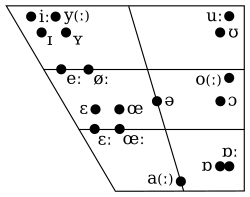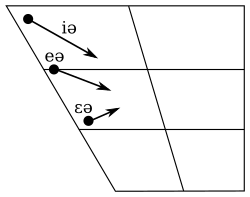Orsmaal-Gussenhoven dialect
The Orsmaal-Gussenhoven dialect is a subdialect of Brabantian spoken in Orsmaal-Gussenhoven, a village in the Linter municipality.[1]
| Orsmaal-Gussenhoven dialect | |
|---|---|
| Native to | Belgium |
| Region | Linter |
Indo-European
| |
| Language codes | |
| ISO 639-3 | – |
| Glottolog | None |
Phonology
Consonants
| Labial | Alveolar | Postalveolar | Dorsal | Glottal | ||||
|---|---|---|---|---|---|---|---|---|
| hard | soft | hard | soft | |||||
| Nasal | m | n | ŋ | |||||
| Stop | voiceless | p | t | tʲ | k | kʲ | ||
| voiced | b | d | ||||||
| Fricative | voiceless | f | s | ʃ | x | h | ||
| voiced | v | z | ʒ | ɣ | ||||
| Approximant | β | l | j | |||||
| Trill | r | |||||||
Obstruents
- /p, b/ are bilabial, whereas /f, v/ are labiodental.[1]
- /ʒ/ is restricted to word-initial position, and occurs only in loanwords from French. It tends to either devoice to [ʃ] or be affricated to [d͡ʒ].[3]
- /k, kʲ/ are velar.[1]
- The exact place of articulation of /x, ɣ/ varies:
- Word-initial /x/ is restricted to the sequence /sx/.[3]
- /h/ may be dropped by some speakers.[3]
- /p, t, tʲ, k, kʲ, v, z/ may be affricated to [p͡ɸ, t͡s, t͡sʲ, k͡x, k͡xʲ, b͡v, d͡z]. Peters (2010) does not specify the environment(s) in which the affrication of /v/ and /z/ takes place. In the case of stops, it occurs in pre-pausal position.[3]
- /v, z/ are realized as voiceless [v̥, z̥] when they occur between vowels, and often also in word-initial position (in which the devoicing may be only partial). /ɣ/ is devoiced in a similar manner.[3]
Sonorants
- /m, β/ are bilabial.[1]
- /n, l, r/ are alveolar.[1]
- /n/ before /k/ is pronounced as follows:
- Word-final [nʲ] appears only in loanwords from French.[3]
- /l/ tends to be velarized, especially postvocalically.[3]
- /r/ has a few possible realizations:
- Apical trill [r] or an apical fricative [ɹ̝] before a stressed vowel in word-initial syllables.[3]
- Intervocalically and in the onset after a consonant, it may be a tap [ɾ].[3]
- Word-final /r/ is highly variable; the most frequent variants are an apical fricative trill [r̝], an apical fricative [ɹ̝] and an apical rhotic affricate [ɾ͡ɹ̝]. The last two variants tend to be voiceless ([ɹ̝̊, ɾ̥͡θ̠]) in pre-pausal position.[3]
- The sequence /ər/ can be vocalized to [ɐ] or [ə].[4]
- /ŋ/ is velar, whereas /j/ is palatal.[1]
- /β, j/ appear only word-initially and intervocalically.[3]
Final devoicing and assimilation
Just like Standard Dutch, Orsmaal-Gussenhoven dialect devoices all obstruents at the ends of words.[3]
Morpheme-final /p, t, k/ may be voiced if a voiced plosive or a vowel follows.[3]
Vowels




The Orsmaal-Gussenhoven dialect contains 18 monophthong and 12 diphthong phonemes. A notable feature of it are quite unusual contrasts between /eː, øː/, /ei, øy/ and /ɛɪ, œʏ/.[5]
| Front | Central | Back | |||||||
|---|---|---|---|---|---|---|---|---|---|
| unrounded | rounded | unrounded | rounded | ||||||
| short | long | short | long | short | long | short | long | ||
| Close | iː | (y) | yː | ə | uː | ||||
| Close-mid | ɪ | eː | ʏ | øː | ʊ, (o) | oː | |||
| Open-mid | ɛ | ɛː | œ | œː | ɔ | ɔː | |||
| Open | a | aː | ɒ | ɒː | |||||
- The majority of the vowels (/iː, y, yː, uː, eː, øː, ə, o, oː, ɛː, œː/) are close to the canonical values of the corresponding IPA symbols.[6]
- /y/ and /o/ occur only in few loanwords from French.[7]
- /yː, uː, ɒː/ before /t, d/ within the same syllable may be realized as centering diphthongs [yə, uə, ɒə], often with a labial glide before the schwa [ywə, uwə, ɒwə]. Alternatively, in place of the schwa an unrounded variant of the first vowel may appear: [yi, uɯ, ɒɑ]. In the same environment, /øː/ can be realized as [øjə].[7]
- /ɪ, ʏ, ʊ/ are phonetically near-close. /ʏ/ is close to the canonical value of ⟨ʏ⟩, yet /ɪ/ and /ʊ/ are more peripheral ([ɪ̟, ʊ̠]) than the canonical values of ⟨ɪ, ʊ⟩.[6]
- /ɛ, œ/ are closer ([ɛ̝, œ̝]) than the canonical values of ⟨ɛ, œ⟩.[6]
- /ɔ, ɒ, ɒː/ are closer ([ɔ̝, ɒ̝, ɒ̝ː] than the canonical values of ⟨ɔ, ɒ⟩.[6]
- /ɔː/ appears only before /t, d/ and only as a phonetic centering diphthong [ɔə].[7]
- /a, aː/, which are phonological back vowels, are central [ä, äː] phonetically.[6]
- When stressed, short vowels cannot occur in open syllables. Exceptions to this rule are high-frequency words like [βa] 'what', and loanwords from French, such as [dəˈpo] 'depot'.[7]
| Closing | uɪ ei øy ɛɪ œʏ əʊ ɞʊ aɪ aʊ |
|---|---|
| Centering | iə eə ɛə |
- The quality of most diphthongs (/uɪ, ei, øy, ɛɪ, œʏ, əʊ, ɞʊ/) is close to the canonical values of the IPA symbols used to transcribe them.[6]
- The starting points of /aɪ, aʊ/ are near-open central [ɐ]. The ending points are [ɪ] and [ʊ], close to the canonical values of the IPA symbols used to transcribe them.[6]
- The starting points of the centering diphthongs /iə, eə, ɛə/ are close to the canonical values of the IPA symbols used to transcribe them ([i, e, ɛ]), whereas their ending points are not fully central but centralized front; [ë] in the case of /iə/, [ë̞] in the case of /eə, ɛə/.[6]
Prosody
Stress location is largely the same as in Belgian Standard Dutch. In loanwords from French, the original word-final stress is often preserved, as in [kəˈdaʊ] 'cadeau'.[7]
Sample
The sample text is a reading of the first sentence of The North Wind and the Sun. The orthographic version is written in Standard Dutch.[9]
Phonetic transcription
[də ˈnœrdərβ̞ɪnt ʔɛn də zɔn ˈʔadən ən dɪsˈkøːsə ˈɛvə də vɾoːx | β̞i van ən tβ̞iː də ˈstɛɾəkstə β̞as | tʏn dʏɪ ʒyst ˈɛmant v̥œrˈbɛːkɔm bə nən ˈdɪkə ˈβ̞aɾəmə ja̰s a̰ːn][4]
Orthographic version
De noordenwind en de zon hadden een discussie over de vraag wie van hun tweeën de sterkste was, toen er juist iemand voorbij kwam met een dikke, warme jas aan.[4]
References
- Peters (2010), p. 239.
- Peters (2010), pp. 239–240.
- Peters (2010), p. 240.
- Peters (2010), p. 245.
- Peters (2010), pp. 240–241.
- Peters (2010), p. 241.
- Peters (2010), p. 242.
- Peters (2010), pp. 241–242.
- Peters (2010), pp. 239, 245.
Bibliography
- Peters, Jörg (2010), "The Flemish–Brabant dialect of Orsmaal–Gussenhoven", Journal of the International Phonetic Association, 40 (2): 239–246, doi:10.1017/S0025100310000083